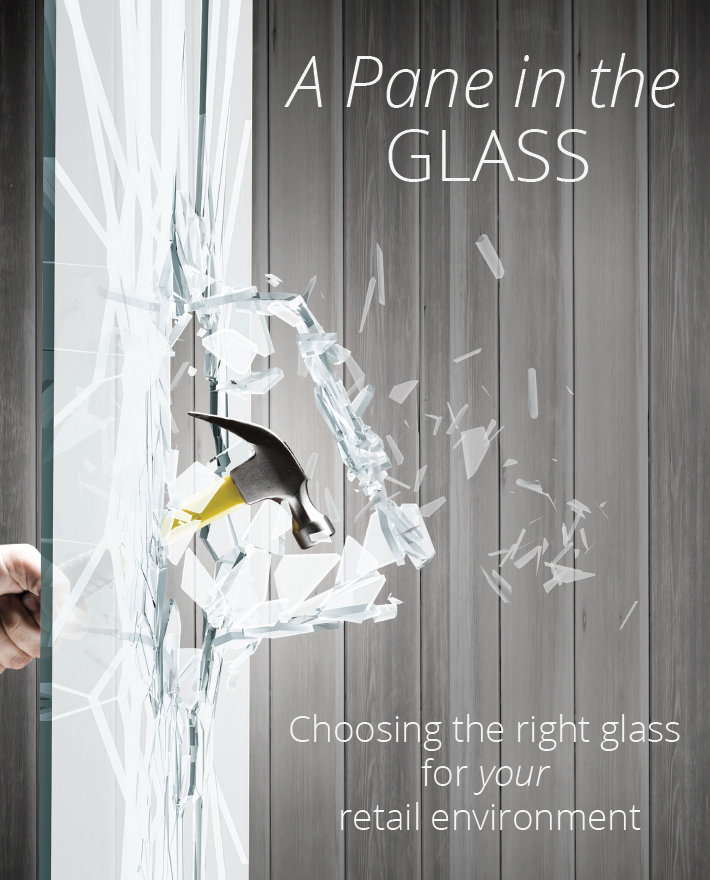Designing a retail space can be challenging while navigating the vast world of materials and their applications.
Choose your glass to match your needs and budget.
Making the right decision can be unclear when you are flooded with information on the varieties of glass available in retail manufacturing.
Here are 4 types of glass commonly used in retail store builds and displays.
Tip: If you are leasing or buying a space, always check to see if there are any restrictions on materials. You may be required to use a specific type of glass which has been approved by the landlords.

1 Float Glass $$$$
(also known as annealed or flat glass)
Float glass is made by floating molten glass on a bed of molten metal allowing it to solidify to a uniform thickness. Worldwide, almost all glass is produced by the floating method.
▶ It is the most cost effective and commonly used glass in retail environments
▶ Almost NO distortion & excellent uniformity
▶ High degree of light transmission
▶ Low face impact
▶ Can shatter into jagged shards when broken
Uses: Float glass is used in areas with low risk of human interaction, such as display cases and decoration.
Did you know? Float glass is used to produce most types of glass. It can be coloured, bent, coated, acid etched, silk screened, made extra clear, tempered, and laminated. It is a unique and extremely versatile material that can be engineered to exhibit optical, thermal, chemical, and mechanical properties.

2 Low-Iron/Extra Clear glass $$$$
(also known as Starphire, Optiwhite, Eurowhite)
Is extra clear glass created by reducing the amount of iron (less than 10%) within its content which removes the green tint.
▶ Moderately higher cost than regular float glass
▶ Almost completely transparent. It offers brilliant clarity
▶ Low face impact (unless tempered or heat strengthened)
▶ Can shatter into jagged shards when broken (unless tempered)
▶ limited sun reflection properties
▶ Scratches may show more, due to the clarity
Uses: Low-Iron glass can be used in Display cases, windows and areas where you need to see the product not the glass. Particularly useful in solar energy applications where it is important that the glass cover lets light through to reach the thermal tubes on photovoltaic cells.
Did you know? The green tint in glass is caused by the silica sand used in the molten mixture of materials required to make float glass. Using a low iron content of silica sand increases the clarity of the glass.

3 Heat Treated glass $$$$
There are two types of heat treated glass:
Heat Strengthened - The glass is subjected to high heat with a slower cooling process. It results in a lower compression strength. It is approximately 2X stronger than regular float glass.
Tempered Glass - (Most commonly used and classified as safety glazing) This glass is subjected to high heat (of approximately 1200°F). Force-cooling is then accelerated to create a higher surface compression in the glass. This process makes the glass 4 to 5 times stronger and safer than float or untreated glass.
▶ Higher cost than float or low-iron. Pricing also depends on what type of glass you are tempering. (ie) are you tempering plain float or low-iron bent glass? The more combinations you have, the higher the cost
▶ Transparency depends on the original glass type that you are tempering
▶ Strong face impact
▶ low edge strength
▶ Shatters into small pieces that are less likely to cause injury or damage than non-tempered glass.
▶ Scratch resistant
Uses: Any place that has a risk to human impact. Medium security display cases, partitions, table tops, shower doors, vehicle windows.
Did you know? The surface of tempered glass is very strong, and it has a high heat strength, but even the slightest impact along the edge could be enough to break the glass. Sheets that have the smallest knicks and imperfections along the edge, or even a frame fit too tightly, will almost certainly shatter with fluctuating temperatures.

4 Laminated Glass $$$$
This type of glass is best for both security and safety. It is made of two or more layers of glass with one or more layers of polymeric material bonded between the glass layers.
▶ Higher cost based on the added manufacturing process and its structural integrity
▶ Transparency depends on the original glass type that you are tempering
▶ It blocks 99% of the UV light transmission
▶ Can be cut and its edges can be polished after laminating
▶ Impact resistant
▶ Glass tends to stay together when one layer is broken, thus qualifying it as a safety glazing material
▶ Sound reduction properties
Uses: High value display cases, window displays, doors, windshields, and anywhere you need that extra layer of security.
Did you know? Laminated glass was inspired by a failed experiment. A glass flask had become coated in a plastic compound, and when it fell to the ground, the chemist Edouard Benedictus was surprised to see the vial hadn’t shattered. Years later he filed for a patent and began creating laminated glass for car windshields, but its potential wasn’t realized until WWII, when gas masks were fitted with laminated eye lenses.

Still have questions?
If you are interested in learning more and want to see these glass types in action, please check out our youtube video Breaking Glass for more information!
For a downloadable version of this blog click here
Should you ever have a question regarding retail fixtures or materials, please contact us at info@thefixturestore.ca today!
Come by and be inspired!


